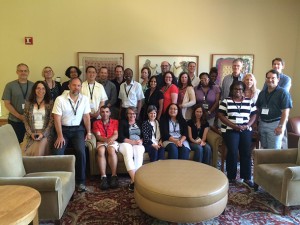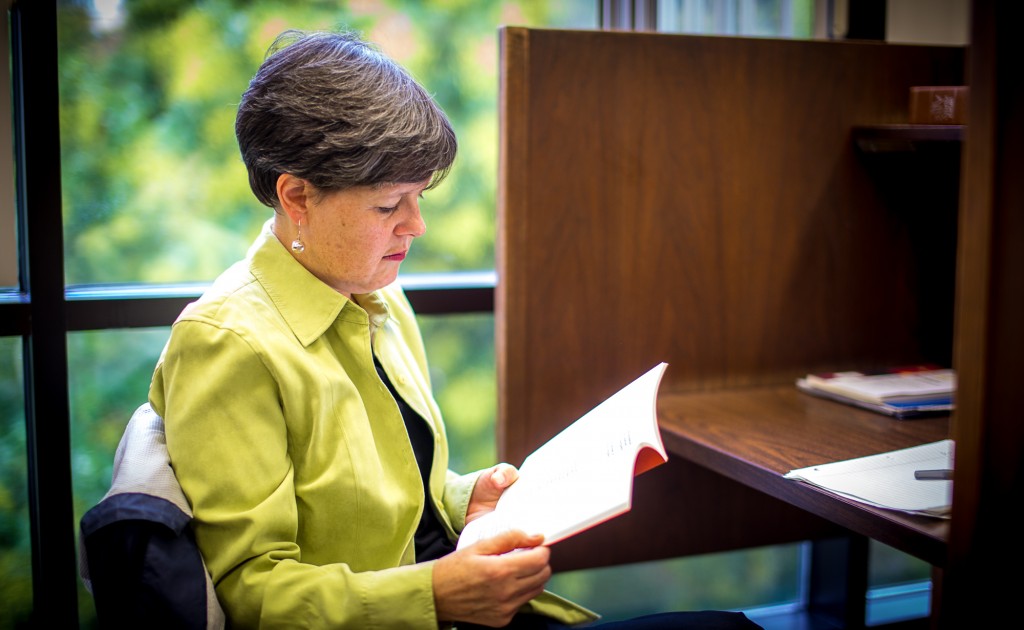During her sabbatical, Eastern Mennonite University English professor Marti Eads is studying how, in one author’s fiction, “the Civil War conflict reverberates in one Appalachian community even after most people there are no longer consciously aware of its relevance.”
For Eads, this theme has resonated since her childhood in western North Carolina.
“My dad remembers hearing his mother talk about overhearing quarrels between her grandfathers,” said Eads. One grandfather had fought for the Confederacy, spending time as a prisoner of war, and the other had fought for the Union.
Eads’ project also includes themes of slavery and historic harms and trauma – both of which she’s integrated creatively into coursework and training, literary research and a dialogue/discussion series with formerly incarcerated men.
Sabbatical allows immersion in important themes
The texts she’s chosen to focus on are by Ron Rash, professor of Appalachian culture studies at Western Carolina University. Rash’s novel The World Made Straight (Henry Holt, 2006) as well as many of his short stories, “consider the ways in which the Civil War conflict reverberates in one Appalachian community even after most people there are no longer consciously aware of its relevance,” she says. [A movie of the same title directed by David Burriss and staring Jeremy Irvine and Noah Wyle was released in 2015.]
Eads has already published one product of her sabbatical, an essay titled “Not Just Whistlin’ Dixie: The Civil War’s Legacy in Ron Rash’s The World Made Straight,” in The Cresset. She continues to read, research, write and dialogue with community members through the end of this semester.
Eads, who has taught English at EMU since 2003, is drawn to teaching texts that focus on trauma and its effects, such as Toni Morrison’s “Beloved,” a novel about a mother who escapes from slavery only to be recaptured and taken back to a plantation in Kentucky.
One reason for that draw is because “EMU students seem to find these texts most meaningful,” she said.
Reading through a trauma awareness lens
As part of her preparation for this multidisciplinary project, Eads underwent some unusual “training.” First, she completed Strategies for Trauma Awareness and Resilience (STAR) Level I training offered by EMU’s Center for Justice and Peacebuilding. The curriculum – learning about cycles of violence, responses to trauma, and the effects of unhealed trauma – led her to different perspectives on the literature she was studying.

Then she traveled to Yale University to participate in a prestigious American history seminar about slave narratives sponsored by the Council of Independent Colleges. In the company of other scholars, she learned more about slavery and abolition in American culture and history.
“Re-reading Harriet Jacobs’ and Frederick Douglass’ slave narratives, which I teach regularly, and reading other slave narratives for the first time through the lens of trauma theory advanced my understanding of the obstacles enslaved people faced,” she said.
One memorable afternoon in Yale’s Bass Library, she perused the first editions of two slave narratives, but “best of all (so poignant!),” she posted to Facebook that day, “was seeing a handwritten manuscript of Jupiter Hammon’s ‘Essay on Slavery.’”
Her colleagues in the seminar, who came from around the United States, were most interested in EMU initiatives for trauma healing such as STAR and Coming to the Table—programs that Eads says “can help people move beyond suffering to hope and healing.”
Eads plans to take the two-day “Transforming Historical Harms” workshop, offered by Coming to the Table, an affiliate program of CJP focused on racial reconciliation, to deepen her knowledge.
Becoming conversant in the language and dialogue of trauma awareness and healing isn’t only useful for textual analysis and teaching, Eads says. As a part of her project, she will be reading short stories and discussing many of these themes with residents of Gemeinschaft Home, a therapeutic, transitional home for individuals recently released or diverted from incarceration located in Harrisonburg.

Great article on an inspirational professor. Go Marti!